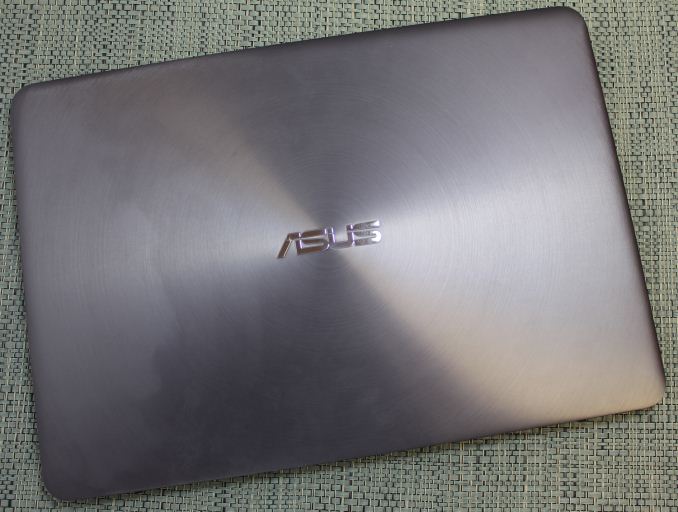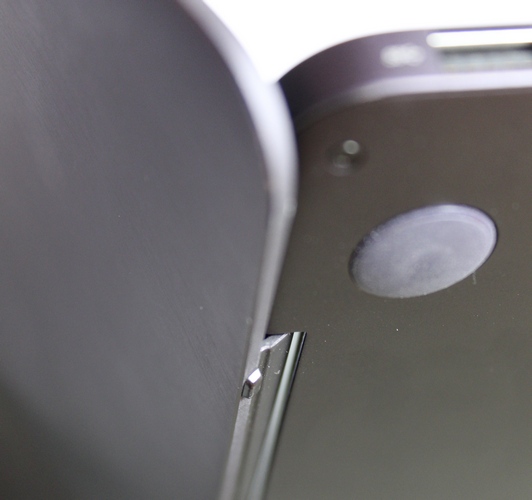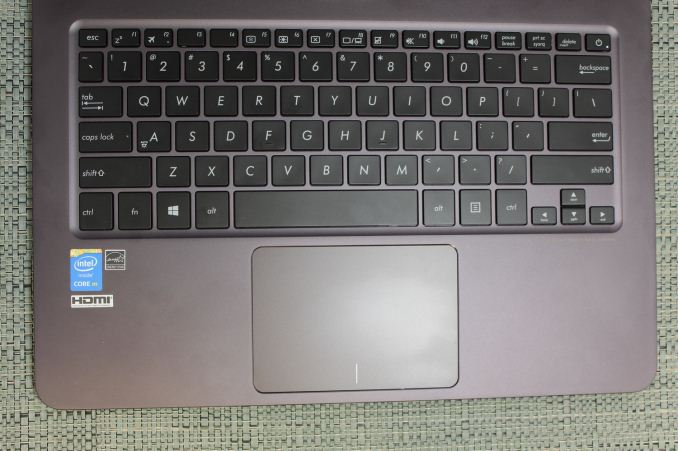The ASUS Zenbook UX305 Review
by Brett Howse on March 25, 2015 8:00 AM ESTDesign and Chassis
People who have seen or used any of the ASUS Zenbooks in the past will be familiar with the overall theme of the design, but the UX305 certainly sits apart from the rest of the lineup. It keeps the beautiful all-aluminum chassis, and the concentric-circles surrounding the ASUS logo on the lid. What sets the UX305 apart is how incredibly thin and light it is. At just 12.3 mm thick, and 1.2 kg in mass, the UX305 just wants to be taken with you. It has a very premium feel with the cool sensation of the aluminum which really makes you forget how little this laptop costs.
ASUS has paid a lot of attention to detail on some aspects of the UX305. One that struck me instantly was opening the lid, which is something many devices do not get right. The UX305 has a very light touch to the hinge, allowing you to open it with just one finger despite the device’s low mass. Of course, the optional touch model will need to have more tension in the hinge, so hopefully they pay as much attention to detail with it as they do the non-touch model. The display will open to 128°, which is a reasonable amount for a traditional notebook computer, but what is strange is the reason for the limited angle on the UX305.
Unlike most devices, the UX305 has a rear hinge which is not attached at the bottom of the display. The hinge attachment on the display is shifted slightly upwards towards the top of the display. This means that when the display is opened, it shifts behind the laptop, and then under it, raising the back of the laptop slightly as it moves from resting on four rubber feet, to the two front feet and the bottom of the display. The display will eventually stop at the maximum opening with the rear of the laptop slightly raised.
This is not the first device I have seen that does this, but it is far from ideal. The laptop has four rubber feet with plenty of grip, but the lid design means that the rear feet are no longer touching the surface. ASUS has prevented the aluminum edge of the display from being the contact point by adding to small plastic nubs on the back of the panel which end up being the feet when the laptop is open. This means that when I am using the UX305 on a soft surface like a wooden table, it can dig in a bit, and on a hard surface it will be less stable than when the four rubber feet are holding it up. To be honest it seems to serve no purpose at all. If it was for increased cooling, ASUS would be better served with a slightly thicker foot. It is certainly not for ergonomics.
Moving on, once the display is open, you can see the island keyboard which is surrounded by the aluminum keyboard deck. The edge of the wrist rest is slightly beveled, which helps a lot from the sharp edges of the aluminum biting into your wrists as has been known to happen on some Zenbooks. While not quite as comfortable as one of the soft touch keyboard decks, there has to be something said about the feel of the cool aluminum when typing. It all feels very premium. The keyboard is good for an Ultrabook, and I could type comfortably on it. Key travel according to ASUS is 1.5 mm. The keyboard layout is very standard, and the only thing that I dislike about the keyboard is that the power button is located on the top right corner above the backspace, and beside delete. Accidentally hitting it will power the device off of course, so it is not ideal. I did not have this happen to me during my time with the ASUS, and this is a common design on the Zenbook series. I think ASUS should move it, but they seem to like it there.
Really the only missing thing on the keyboard is backlighting. Premium devices generally have this, so it is confusing that the ASUS does not until you think about the price. The ASUS feels very premium, so in your mind it should have backlighting, but then you have to remember that this is a lower cost entry, which keeps higher cost items like 8 GB of memory and a 256 GB SSD, so to hit the price point they did some sacrifices were made, and backlighting was one of them.
The trackpad is quite large, and easy to use. It is 105 mm x 73 mm (4.13” x 2.87”) and there were no issues with usability. Tapping was never an issue, and two-finger scrolling worked well. The surface is very smooth and easy to glide over. The driver for the touchpad is provided by ASUS, and it seems like they are trying to move away from some of the poor touchpad experiences that have bitten them in the past. There is of course plenty of settings for various gestures to be enabled or disabled, and the left/right click can be reversed. My experience with the UX305 was that it was not the best touchpad I have ever used, but it is close. The drivers combined with the large surface area made the UX305 very easy to use.
The UX305 has a full complement of ports on the side, with two USB 3.0 ports on the left along with a SD card reader, and a third USB 3.0 port on the right along with the power connector, headset jack, and micro-HDMI port. There is of course no room for an Ethernet port on such a slim device, but ASUS is nice enough to include a USB 3.0 Ethernet adapter in the box. For those that need it, this is a nice bonus.
The speakers are downward firing through two grilles on the bottom of the device. Each speaker is 25 mm x 9 mm x 3 mm (meaning they are not round) and are set in a 1.7 cubic centimeter housing. ASUS has even gone to the trouble of ensuring the speaker wire length is equal on both sides. We will see later how well they perform.
The design of the UX305 continues in the tradition of the Zenbook, and is really a beautiful machine to look at, pick up, and use. The design is not perfect, mostly due to the display being used to elevate the device when open, but this is a relatively small thing when you consider the premium materials used to construct this very thin, and very portable device. When you consider the price point, ASUS has done a fantastic job overall.
















164 Comments
View All Comments
Calista - Wednesday, March 25, 2015 - link
Well, for a lot of people a Core 2 Duo is more than powerful enough. Using a M4400 with a Core 2 Duo T9600 from time to time rarely does it feel slow for "normal usage", i.e. browsing the web, working with Photoshop and whatnot.Once we have reached a certain threshold more performance just doesn't seem so important any more. I would say most folks reached that threshold with the release of the later C2D CPU:s.
FlushedBubblyJock - Wednesday, March 25, 2015 - link
I know many of these people, and replacing the spindle drive with a small SSD (and my usual optimizations in 5 mins) settles it entirely for them.It's faster than the new regulars at the stores.
TheWrongChristian - Thursday, March 26, 2015 - link
I just "upgraded" from my Core Duo T2400 based laptop (which kept up with modern software) to a $60 second hand thinkpad t61, with Core 2 T7100 CPU (which easily keeps up with modern software.)I only upgraded because the screen backlight on the old laptop was a bit flaky, and only upgraded to the thinkpad because it has a fantastic keyboard and I already had the ultrabay HDD adaptor from a previous work laptop, as well as using the same PSU as my old laptop (also a Lenovo.)
Modern machines are let down by their crappy keyboards and screens. That's where the race to the bottom has hit.
TL;DR
I concur. With the push of software down to tablet and smartphones, people have learned to somewhat optimize again, and CPUs performance from ~7-8 years ago is perfactly adequate.
akdj - Saturday, March 28, 2015 - link
Except I'd argue your two biggest concerns (keyboard and screen) are ..at least ½ of the equation ... Of MUCH higher quality, legibility, brightness, contrast, and their corresponding technologies behind them; AMOLED or LCS have come leaps and bounds in the last half to full decade. I'm also intrigued by the new keyboard and trackpad Apple has implementedIf anything, it does seem more Window's OEMs are getting trackpads correct. I can't speak to their keyboards but I've been using solely OS X laptops during that time period you're talking about. Though, during that period Apple's keyboards, again, have only gotten 'Better'. Just MHO, but not a lot of laptops are upgradable either, some 32bit even limited to 3-3.5GB of RAM & nearly impossible to get an SSD inside. That, the SSD today is the ONE differentiator and bottle neck eliminator we've seen. Not the CPU, the RAM, the display or the keyboard. GPU in some cases, sure. But going solid state and fanless without the need for AC all day...for the layman, those are HUGE wins
BrokenCrayons - Thursday, March 26, 2015 - link
I completely agree with the C2D being adequate. For me, "adequate performance" was an upgraded Dell Latitude D620 with a T2300 (1.6 GHz 32-bit dual core), 4 GB of RAM which wasn't fully utilized due to the 32-bit OS and a thing about the 945 chipset that didn't recognize more than like 3.2 GB and a 320 GB non-SSD. It was and still is just fine but the battery was bad, the screen was getting kinda flickery and one of the USB ports was damaged so I bought a used Latitude E6320 with some kind of i5 Sandy Bridge in it and it's far more than I need. While I like the fanless aspects of modern laptops, I hate the short key travel and other sacrifices made in the name of making something thin. It seems pointless and faddish to do that because the laptop still needs just as much space in a handbag or whatever since the other two dimensions aren't different. I'm sure that some people will want something like this, but I can't find a reason to care that much about the thickness. I didn't care when I had a 90 MHz Pentium laptop (which was fanless...Texas Instruments Travelmate 5130..there was a heatsink and this huge heat spreader bar under the keyboard) and I don't worry about it now.074geodude - Wednesday, March 25, 2015 - link
CPU performance wise, no you will not be upgrading.But everything else - screen quality, resolution, thickness, weight, 8 GB RAM, 256 GB SSD, battery life (11+hours, try getting that out of a Core 2 Duo).
It's time to upgrade.
beehofer - Thursday, March 26, 2015 - link
The Core M might not stand much a of chance against the the U but they seem to have a purpose. I would very much like a review of the new more powerful Asus UX303LA which is sporting the 5200U. I got it from the microsoft store for 1300$ after adding a 1TB EVO 850 SSD. the screen is higher ppi than the newest 13 inch macbook pro retina with 8GB of Ram. You can't beat the bang for the buck. Battery life is the only disappointment so far.sonicmerlin - Monday, March 30, 2015 - link
Even the iPad Air 2 has a faster GPU than Core M.FwFred - Monday, June 15, 2015 - link
I'd say the GPUs trade blows, but the Core M has faster CPU, and the Asus has far more storage for an equivalent price.Novacius - Wednesday, March 25, 2015 - link
It's a shame that it hasn't keyboard backlighting and such a poor display calibration. Maybe they'll do better in future iterations. I'm very interested in a Skylake model.